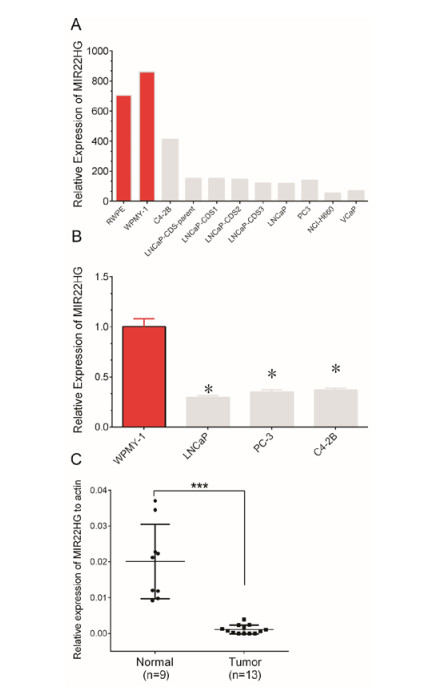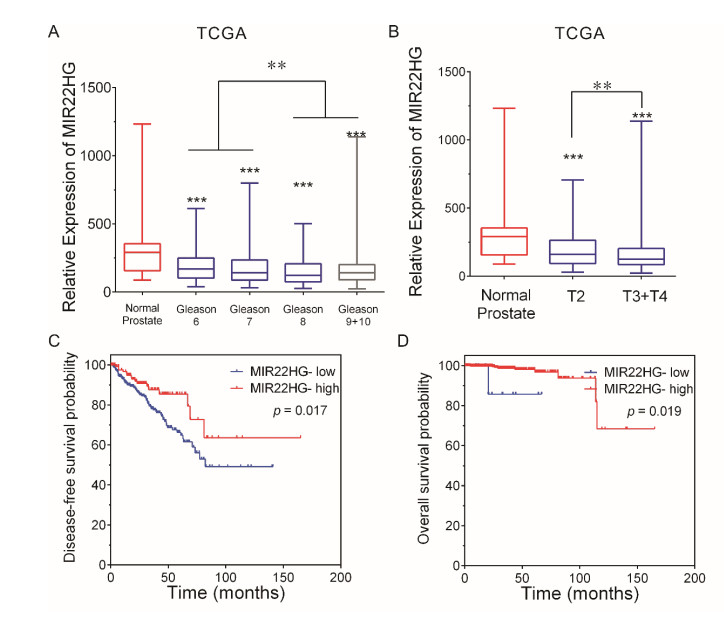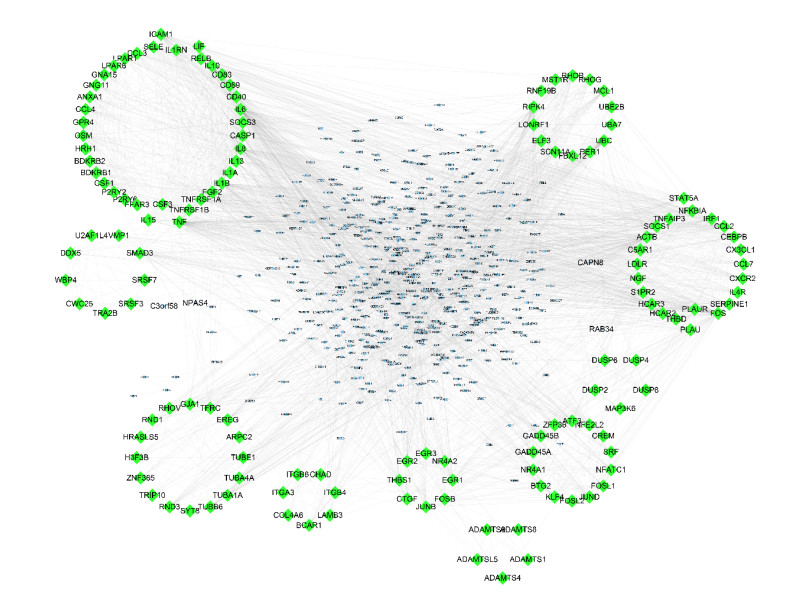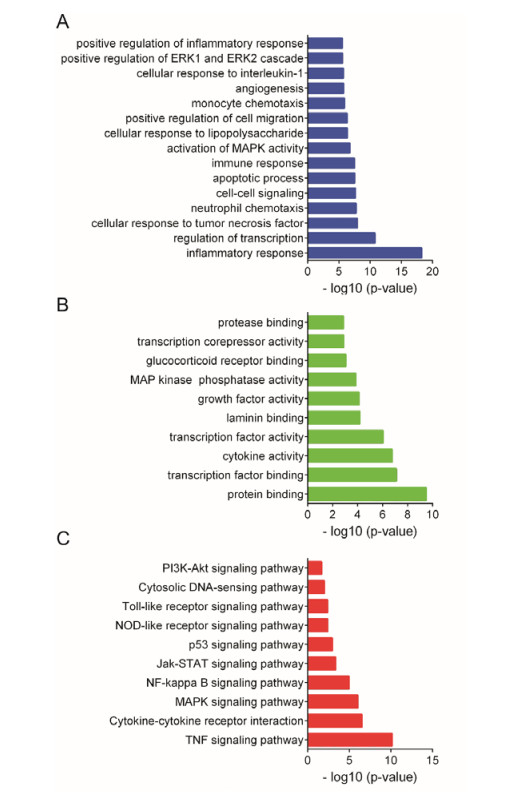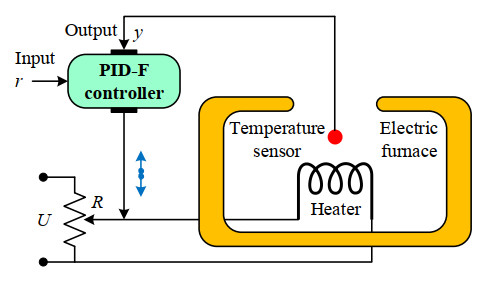1.
Introduction
Long noncoding RNAs were a type of RNA transcripts longer than 200 nucleotides. Emerging evidence indicated lncRNAs acted as key regulators in cancer tumorigenesis. A series of lncRNAs, such as GAS5, HOTAIR, NEAT1, and XIST, were abnormally expressed in various types of human cancers [1,2,3,4,5,6,7]. LncRNAs could also be classified into tumor-suppressive and oncogenic genes by regulating gene expression through transcriptional and post-transcriptional regulation. Prostate cancer (PCa) is the one of the most common malignancy in males. Recent studies had also focused on exploring the roles of lncRNAs in the progression of PCa. For example, White et al. found that low PCAT-14 expression associates with poor outcomes in PCa [8]. Chinnaiyan et al. reported ARLNC1 (AR-regulated long noncoding RNA 1) promoted PCa growth in vitro and in vivo [9]. However, the functional roles of most lncRNAs in PCa remained to be further investigated.
MiRNA host genes (MHG), a special type of lncRNAs, were revealed to be involved in regulating many biological processes, such as cetuximab resistance, metastasis, and cell proliferation. For instance, MIR31HG promoted lung cancer proliferation [10]. MiR210HG induced Osteosarcoma cell invasion and metastasis by sponging miR-503 [11]. MIR22HG was identified as a tumor suppressor in recent studies. Cui et al. found MIR22HG inhibited endometrial carcinoma proliferation by suppressing miR-141-3p [12]. Zhang et al. found MIR22HG overexpression suppressed hepatocellular carcinoma cell proliferation [13]. However, the expression pattern and function roles of MIR22HG in PCa remained unknown.
In the present study, we explored whether MIR22HG could serve as a biomarker for TC by analyzing public TCGA and GEO datasets. Meanwhile, we performed co-expression, GO analysis, and KEGG analysis to reveal the functional roles of MIR22HG in PCa. We thought this study will provide a novel prognostic biomarker for PCa.
2.
Materials and methods
2.1. Microarray data
A series of microarray datasets, including GEPIA, GSE6919 [14,15], GSE55945 [16], and GSE45016 [17] were downloaded from GEO (https://www.ncbi.nlm.nih.gov/geo/). GSE6919 was contributed by Chandran and GSE55945 was contributed by Arredouani. GSE45016 was contributed by Satake which contains 10 frozen specimens from high-grade PCs with high PSA levels and a high Gleason score (GS). The TCGA dataset of PCa contains 52 normal samples and 492 tumor samples. The clinical information of MIR22HG was download from cBioPortal (http://www.cbioportal.org/).
2.2. Co-expression network construction and analysis
MIR22HG co-expressed genes were analyzed. MIR22HG -gene pairs with the absolute value of the Pearson correlation coefficient ≥ 0.4 were selected as candidates. Cytoscape was used to present the network.
2.3. GO & KEGG pathway analysis
MAS3.0 system (http://mas.capitalbiotech.com/mas3/) was a whole data-mining and function annotation solution to extract & analyze biological molecules relationships. We used MAS3.0 system to present the GO and KEGG analysis.
2.4. Confirmation of MIR22HG expression in clinical samples and cell lines
This study was approved by the Research Ethics Committee of Renmin Hospital of Wuhan University. A total of 9 normal and 13 tumor samples were obtained from Renmin Hospital of Wuhan University. Written informed consent was obtained from the patients with PCa. All patients did not have any other treatment before surgery. LNCaP, WPMY-1, PC-3 and C4-2B cells were obtained from Cell Bank of Chinese Academy of Sciences (Shanghai, China) and cultured in 1640-media supplemented with 10% FBS (Gibco, USA).
2.5. Real-time PCR (qRT-PCR) analysis
Total RNAs of samples and cell lines were extracted using TransZol Up Plus RNA Kit (TransGenBioTech, China). Reverse transcript PCR was carried out using PrimeScrip RT reagent Kit (TaKaRA, China). qRT-PCR was carried out using SuperRealPreMix Plus (TIANGEN, China) on Roche LightCycler 480. β-actin was selected as a reference. The primers for MIR22HG: Forward, 5’- CGGACGCAGTGATTTGCT-3’; reverse, 5’-GCTTTAGCTGGGTCAGGACA-3’. The 2-ΔΔCt method was used to calculated data.
2.6. Statistical analysis
Data were shown as a mean ± standard. The student’s t-test was used to compare between two groups of data. The Kaplan Meier plotter datasets were used to present the clinical significance of MIR22HG in PCa. The one-way analysis of variance (ANOVA) was used to compare between multiple groups. P < 0.05 was selected as significant.
3.
Results
3.1. Long non-coding RNA MIR22HG was downregulated in prostate cancer
To evaluate MIR22HG expression pattern in PCa, publicly available data from GEO and TCGA datasets were analyzed. As shown in Figure 1A-D, we first observed MIR22HG was significantly downregulated in PCa samples compared to normal samples by analyzing four publicly available gene expression datasets, including GEPIA, GSE45016, GSE6919, and GSE55945. Furthermore, we analyzed TCGA datasets and also found MIR22HG was down-regulated in PCa samples compared to normal prostate samples (Figure 1E).
3.2. Validation the expression pattern of MIR22HG in prostate cancer
Next, qRT-PCR assays were performed to validate MIR22HG expression in PCa cell lines and clinical samples. As shown in Figure 2, we found MIR22HG was down-regulated in PCa cell line, including LNCaP, PC-3, and C4-2B, compared with normal prostate cell line WPMY-1(Figure 2B, P < 0.05). These results were similar to the analysis based on Prensner et al. Dataset [18] (Figure 2A). Furthermore, we validate MIR22HG expression in 13 PCa tissues and 9 non-tumor samples. Our results showed that MIR22HG was significantly decreased in PCa tissues compared with non-tumor tissues (Figure 2C, P < 0.001).
3.3. Correlations between MIR22HG expression and clinicopathological features in prostate cancer specimens
Furthermore, we analyzed correlations between MIR22HG expression and clinicopathological features in prostate cancer specimens. Of note, our results showed that MIR22HG was significantly reduced in Gleason 6, Gleason 7, Gleason 8 and Gleason 9 + 10 PCa samples compared to the normal controls (Figure 3A, P < 0.001). Furthermore, we found MIR22HG was down-regulated in PCa with a Gleason score ≥ 8, compared with tumors with low Gleason score (≤ 7) (Figure 3A).
By analyzing its expression pattern based on T staging, we found that T2 (P < 0.001) and T3 + 4 (P < 0.001) PCa samples had lower expression of MIR22HG compared to the normal tissues (Figure 3B). Moreover, the expression level of MIR22HG was also decreased in pT3a, pT3b and T4 stages PCa as compared with pT2a, pT2b and pT2c stages PCa samples (P < 0.01) (Figure 3B).
In order to further investigate the clinical significance of MIR22HG in prostate cancer, we performed a Kaplan-Meier analysis. We found higher MIR22HG expression was significantly correlated with better disease-free survival time and overall survival time in prostate cancer (Figure 3C, D). These results suggested MIR22HG could act as a biomarker and prognostic target for prostate cancer.
3.4. Construction of MIR22HG-mediated PPI networks in prostate cancer
By using the “guilt-by-association” approach, we predicted the potential roles of MIR22HG by analyzing its co-expressing mRNAs. We performed a co-expression analysis for MIR22HG in prostate cancer. The absolute value of the Pearson correlation coefficient ≥ 0.40 were selected as a cutoff to identified reliable MIR22HG-mRNA pairs.
Furthermore, we constructed MIR22HG-mediated PPI networks in prostate cancer by using its co-expressing mRNAs (combined score > 0.4) based on the STRING database [19,20]. As shown in Figure 4, this network contained 510 proteins and 3017 edges. Mcode plugin was performed to identify key genes (degree cut-off ≥ 2 and the nodes with edges ≥ 2-core) in this network. Key genes were labeled with green color (Figure 4).
3.5. Bioinformatics analysis of MIR22HG in prostate cancer
We next performed GO analysis by using the DAVID system. GO analysis showed that MIR22HG co-expressed genes were significantly associated with inflammatory response, regulation of transcription, cellular response to tumor necrosis factor, neutrophil chemotaxis, cell-cell signaling, apoptotic process, immune response, activation of MAPK activity, cellular response to lipopolysaccharide, and positive regulation of cell migration (Figure 5A). Molecular function analysis showed MIR22HG was involved in regulating protein binding, transcription factor binding, cytokine activity, transcription factor activity, laminin binding (Figure 5B).
KEGG pathway analysis showed MIR22HG was involved in regulating TNF signaling pathway, Cytokine-cytokine receptor interaction, MAPK signaling pathway, NF-kappa B signaling pathway, Jak-STAT signaling pathway, p53 signaling pathway, NOD-like receptor signaling pathway, Toll-like receptor signaling pathway, Cytosolic DNA-sensing pathway, and PI3K-Akt signaling pathway (Figure 5C).
4.
Discussion
By analyzing TCGA, GEPIA, GSE6919, GSE55945, and GSE45016 datasets, our findings indicate that MIR22HG was downregulated in prostate cancer and correlated with clinic pathologic features and disease-free survival time of PCa. Bioinformatics analysis showed MIR22HG was significantly associated with regulating the inflammatory response, regulation of transcription, cellular response to tumor necrosis factor, neutrophil chemotaxis, cell-cell signaling, TNF signaling pathway, Cytokine-cytokine receptor interaction, MAPK signaling pathway, NF-kappa B signaling pathway, and Jak-STAT signaling pathway. These studies indicated MIR22HG might be a prognosis biomarker in PCa.
The initiation and progression of PCa is a complicated process involved in the dysregulation of various genes, such as AR, miRNAs, and transcription factors (TF). Moreover, multiple biomarkers, such as PSA glycoforms, TMPRSS2: ERG fusion gene, microRNAs, circulating tumor cells, lncRNAs, androgen receptor variants, and PTEN gene were revealed to be promising biomarkers for PCa prognosis [21]. Recent studies indicated lncRNAs also participated in regulating PCa tumorigenesis and could serve as novel biomarkers for PCa. A few lncRNAs were reported to be differently expressed in PCa, such as PCA3, TUG1 [22], HOTAIR, RNCR3 [23], and ARLNC1. For example, HOXD-AS1 regulated proliferation and chemo-resistance of castration-resistant PCa via recruiting WDR5 [24]. LncRNA PCA3 was more sensitive than traditional biomarker PSA in PCa diagnosis. In the present study, we focused on the roles of MIR22HG in PCa. First, we evaluated the expression pattern of MIR22HG in PCa by using GEPIA, GSE6919, GSE55945, GSE45016, and TCGA datasets. Then, we detected the endogenous expression level of MIR22HG in cell lines and in clinical samples excised from PCa patients by using a quantitative assessment of qRT-PCR. We found MIR22HG was significantly downregulated in human PCa tumors compared to non-cancerous prostate tissues. Moreover, we found the lower expression levels of MIR22HG were significantly related to higher Gleason and T stage. Kaplan-Meier analysis indicated higher MIR22HG expression was associated with longer disease-free survival time in PCa. These results suggested MIR22HG could serve as a novel biomarker for PCa.
Recent studies indicated miRNA host genes (MHG) played crucial roles in human cancers via regulating multiple biological processes. For example, Lu et al. found MIR100HG was up-regulated in cetuximab-resistant colorectal cancer and head and neck squamous cell cancer cells [25]. MIR100HG-derived miR-100 and miR-125b coordinately activated Wnt signaling to mediate cetuximab-resistant in cancer cells [25]. MIR22HG was a miRNA host gene and downregulated in lung cancer and hepatocellular carcinoma. MIR22HG was found to be involved in chemical stress response and hypoxia response. A recent study showed MIR22HG overexpression suppressed hepatocellular carcinoma cell proliferation [13]. However, the roles of MIR22HG in PCa remained largely unclear. In the present study, we constructed a MIR22HG mediated PPI network, which contained 510 proteins and 3017 edges. Bioinformatics analysis showed MIR22HG significantly associated with inflammatory response, regulation of transcription, cellular response to tumor necrosis factor, neutrophil chemotaxis, cell-cell signaling, TNF signaling pathway, Cytokine-cytokine receptor interaction, MAPK signaling pathway, NF-kappa B signaling pathway, and Jak-STAT signaling pathway.
5.
Conclusion
In conclusion, this study for the first time showed MIR22HG was down-regulated in PCa. Furthermore, we observed the lower expression levels of MIR22HG were significantly related to higher Grade, T stage, N stage and shorter disease-free survival time in PCa. Bioinformatics analysis showed MIR22HG was associated with inflammatory response, regulation of transcription, and TNF signaling pathway. These results showed MIR22HG could serve as a novel biomarker for prostate cancer.
Acknowledgements
This study was supported by Application and Basic Research Project of Wuhan City (No. 2015060101010049), Wuhan Morning Light Plan of Youth Science and Technology (2017050304010281), Hubei Province Health and Family Planning Scientific Research Project (No. WJ2017M025, No. WJ2017Z005 and WJ2018H209), Natural Science Foundation of Hubei Province (No. 2016CFB114, 2017CFB181) and Research Project of Wuhan University (No. 2042017kf0097).
Conflict of Interests
The authors declare that they have no competing interests, and all authors should confirm its accuracy.
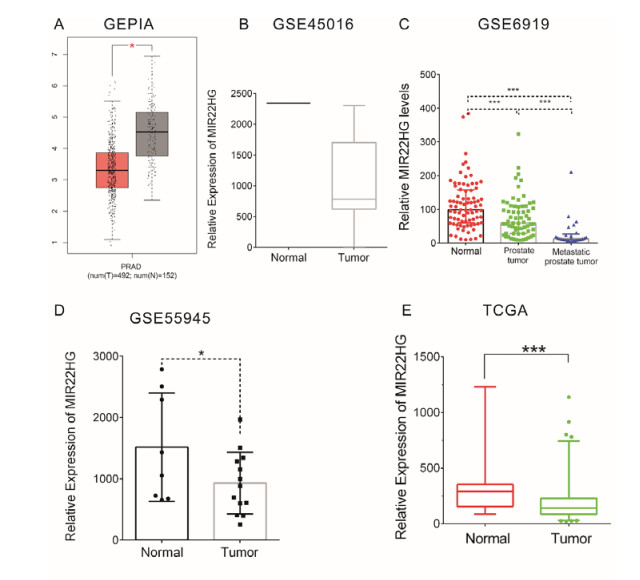









 DownLoad:
DownLoad:
